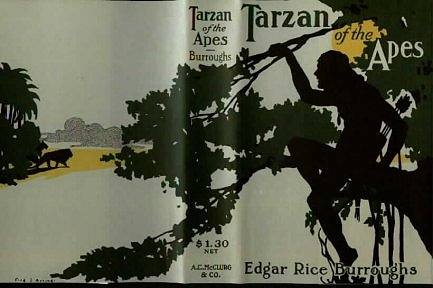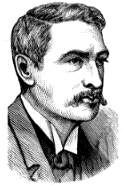Edgar Rice Burroughs wrote one of the most famous stories of African
adventure in his Tarzan
of the Apes. It was first published in The
All-Story magazine in October
1912. Although the theme of a wild boy living with animals in
the jungle was most notably written by Kiplingin
his two Jungle
Books (seven stories and seven poems published in 1894, followed
by eight stories and eight poems in 1895) the tales take place in colonial
India rather than Africa. Burroughs had never visited Africa, so
his background information came from books or his own imagination.
Indeed, Holtsmark has written persuasively about his jungle as a
"psychological landscape" rather than as a place in the real world. (Holtsmark,
7-12).
The first great African adventure story was written by H.
Rider Haggard, followed by many other African tales based upon his
own personal experiences beginning in 1875 when he went out to Natal with
Sir Henry Bulwer. His first published work was a non-fiction study
of Cetewayo and His White Neighbors published in 1882.
"Although many soldiers, travelers and hunters wrote about their
experiences in Africa there were surprisingly few novels set there.
. .. King Solomon's Mines was the first African story to find
a wide readership (Higgins 84).
H. Rider Haggard's King
Solomon's Mines of 1885 was wildly successful. With its publication
Haggard became the talk of the literary world. The story was written
in six weeks on a dare by his brother who bet him he could not write anything
to match Robert Louis Stevenson's
Treasure
Island (1882). Stevenson himself wrote Haggard a series of
letters of praise mixed with criticism, ending with the postscript, "How
about a deed of partnership." He could ask for no higher accolade.
(Pocock, 62-63).
In 1872 Henry
Morton Stanley
published his "How I Found Livingstone in Central Africa". It was
a phenomenal success, selling by ten of thousands and was was into its
third edition in a single month. Although this was not a work of
fiction, the historic events he described seemed almost fantastic, the
Mirambo war, the ordeal with the Ha, the crossing of the Malagarazi and
the meeting with Livingston, the saint of Victorian explorers. (McLynn,
224). This book was followed by Through
the Dark Continent in 2 vols. in 1878, the account of his crossing
the entire continent, concluding with his epic trip down the Congo river.
In his bibliography, McLynn lists 53 notable book titles on African exploration
available in English before 1911. Of course, there were hundreds
more, but his list is interesting and indicates some of the many titles
available to Burroughs. Atamian thinks that two books were especially
relevant in the creation of Tarzan of the Apes, namely, Paul Du Chaillu's
Explorations
and
Adventures in Equatorial Africa (1861) and J.W. Buell's Heroes
of the Dark Continent (1889). (Atamian, 22).
The influence of Stanley's work is evident in ERB's Tarzan series.
However, Haggard's Allan
Quatermain is usually associated with the big game hunter, Selous,
whose A Hunter's
Wanderings in Africa of 1881 attracted much attention. "It
is unlikely that the book was unknown to Haggard, whose interest in Africa
was constantly refreshed by the purchase and thorough study of a large
number of non-fiction books about it" (Higgins, 72). Of course, Haggard
had his own African experiences as a source for his writing as well.
The following list records Haggard's 22 African books which would have
been available to Burroughs before his writing of
Tarzan
of the Apes.
1882 - Cetywayo and His White Neighbors: or, Remarks on Recent Events
in Zululand, Natal, and the Transvaal
1885 - The Witch's Head - a dramatic description of Isandhlwana
1885 - King
Solomon's Mines
1887 - Jess - A love story against the backdrop of the Boer
War.
1887 - Allan
Quatermain
1887 - She
1888 - Maiwa's
Revenge
1889 - Cleopatra
1889 - Allan's
Wife And Other Tales
1892 - Nada
the Lily
1894 - The People of the Mist
1896 - The
Wizard
1898 - Allan The Hunter. A Tale of Three Lions (Collected
in "Allan's Wife and Other Tales.")
1899 - Swallow. A Tale of the Great Trek
1899 - The Last Boer War. Actually an abridged version of
his first book.
1900 - Black
Heart and White Heart and Other Stories
1905 - The Return of She: Ayesha
1906 - Benita.
An African Romance. An adventure tale involving clairvoyance
and an African treasure. The New York edition was titled "The Spirit
of Bambatse."
1909 - The Lady of the Heavens A competent telling of
how yet another white woman is welcomed as a goddess by an African tribe.
Called "The Ghost Kings" in England.
1908 - The
Yellow God. An Idol of Africa.
1910 - Morning
Star. A romance of ancient Egypt.
1910 - Queen
Sheba's Ring

Bibliography
Atamian, Sarkis, The Origin of Tarzan: The Mystery of Tarzan's
Creation Solved, Publication Consultants, 1997.
Higgins, D.S. Rider Haggard: A Biography, Stein
and Day, 1983.
Holtsmark, Erling, B. Tarzan and Tradition: Classical
Myth in Popular Literature, Greenwood Press, 1981.
McLynn, Frank, Stanley: The Making of an African Explorer,
Scarborough House, 1990.
Pocock, Tom, Rider Haggard and the Lost Empire: A Biography,
Weidenfeld & Nicolson, 1993.
|





![]()
![]()

![]()
![]()
![]()
